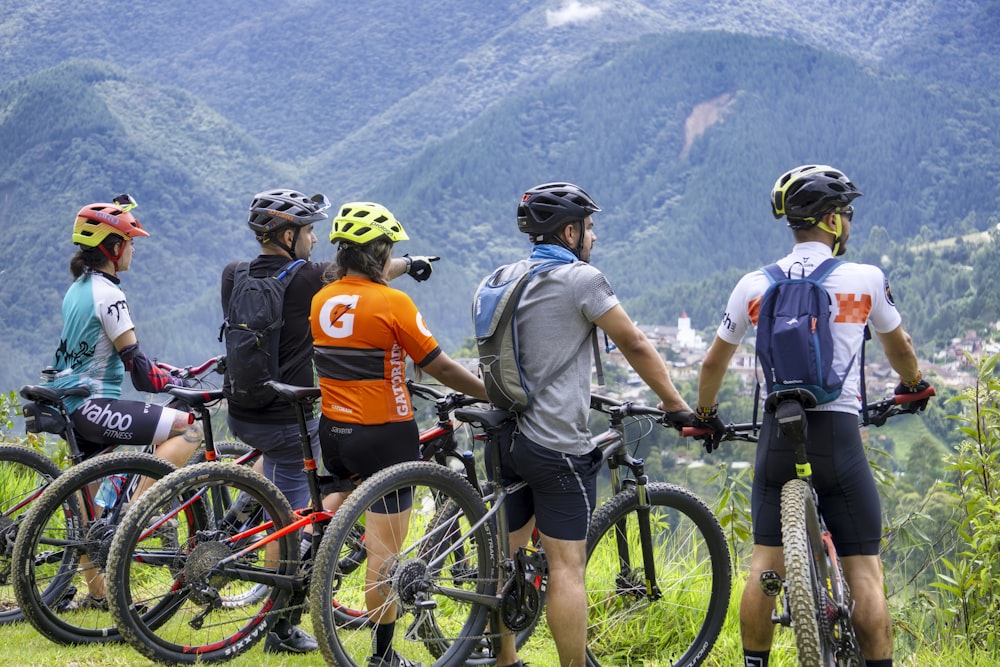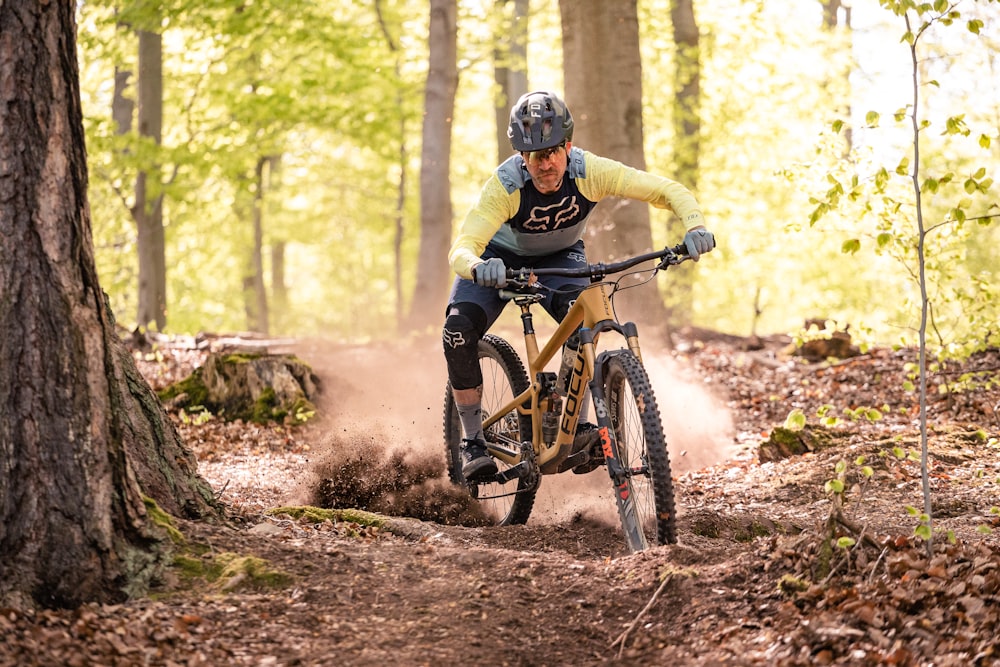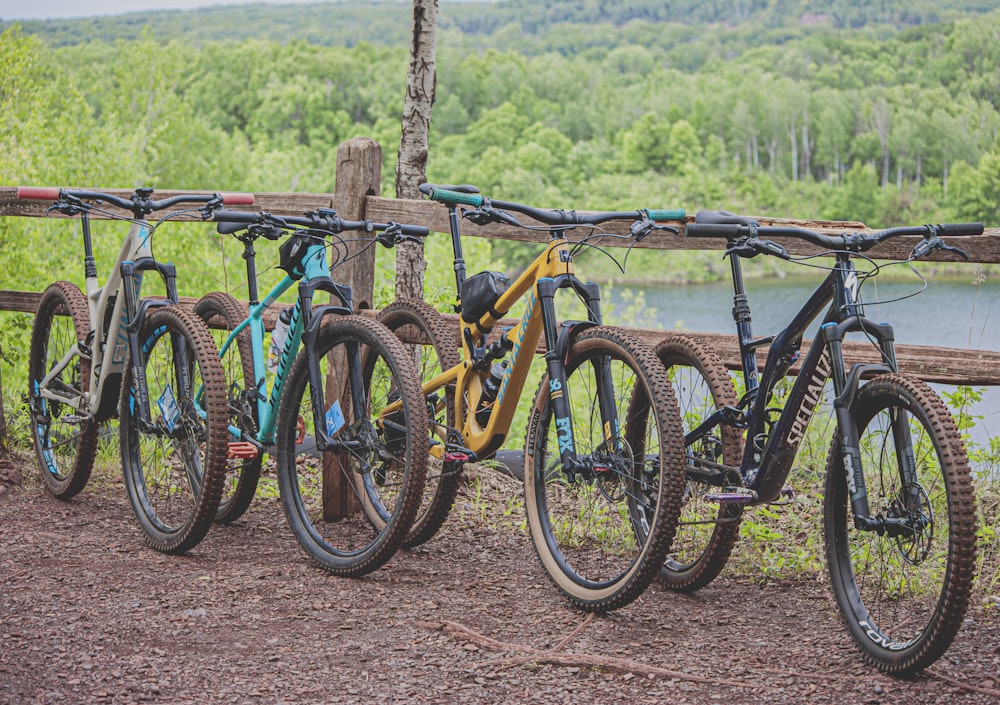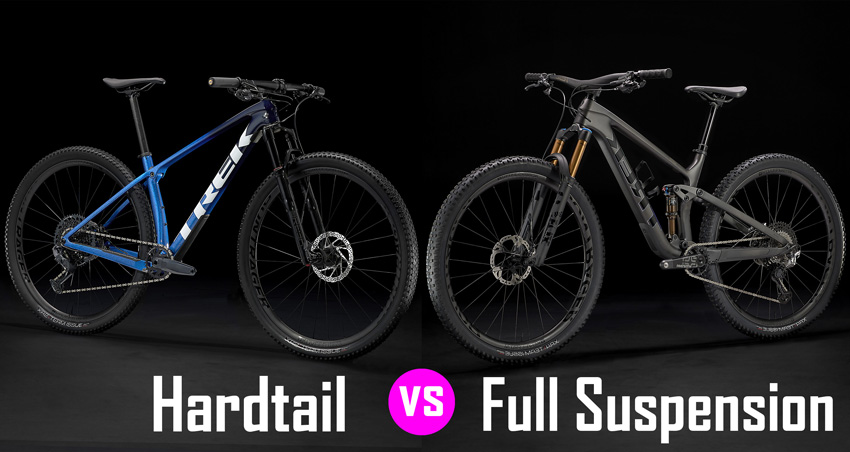
Image source: trekbikes.com
Having a bike that matches your riding style makes cycling much more enjoyable, so deciding between a hardtail or a full-suspension bike will make a big difference.
For example, riding on the road, undulating cross-country trails, or fast downhill singletrack covered in roots and rocks each necessitates a bike with different abilities. The right bike will allow you to perform well in a specific domain and maximize safety and enjoyment. Suspension helps to absorb impacts but can also affect the efficiency of pedal strokes.
This article will explain the differences between hardtail and full-suspension mountain bikes and their pros and cons. Read on to find out what style of bike will work best for you!
What Is a Hardtail Bike?

A hardtail is simply a mountain bike with a front suspension fork and a rigid rear end. Although other bike styles (like hybrids) use front suspension, the term hardtail is reserved for the mountain bike category.
Hardtails are great for riders who enjoy off-road riding but don’t tackle the most technical and rough trails. They are faster than full suspension bikes on pavement, light dirt trails, and going uphill because they’re lighter and don’t have rear suspension (which reduces pedaling efficiency).
Having suspension on the front will cushion the light to moderate impacts, making trail riding more comfortable and stable when compared to a bike without suspension. In addition, anyone comparing a full suspension to a hardtail mountain bike will notice a significant increase in pedaling efficiency when riding the hardtail.
Related reviews:
What Is a Full-Suspension Bike?
A full-suspension bike is a bike that has fork suspension and a rear shock over the rear wheel, integrated into the frame. The amount of suspension on a full-suspension MTB differs hugely based on the discipline (cross-country, enduro, all-mountain, downhill, etc.).
Riders who ride rougher trails will find a full-suspension bike is the best choice to handle their demands. Full suspension bikes are ridden for leisure and racing more than for transportation and general use as they are more expensive than hardtails, harder to maintain, and less efficient on roads or smooth trails.
Finally, full-suspension bikes are almost always mountain bikes; however, some full-suspension gravel bikes and moped-style e-bikes exist. This article will address full-suspension mountain bikes only.
Related reviews:
- Best Full-Suspension Mountain Bikes Reviews
- Best Short-Travel Full-Suspension Mountain Bikes 100 to 130mm
- Best Trail & All-Mountain Bikes (130-160 mm travel)
- Best All-Mountain & Enduro Bikes with 150-180 mm Travel
- Best Full-Suspension Mountain Bikes Under $3,000
- Best Full-Suspension Mountain Bikes Under $4,000
- 7 Best Kids Full Suspension Mountain Bikes
Hardtail vs. Full Suspension Bikes Compared
Comparing a hardtail vs. a full suspension mountain bike is relatively straightforward as the most important difference is obvious; a hardtail doesn’t have a rear shock or pivot components. However, most of the other parts are pretty similar, including the frame materials, wheels, tires, and drivetrains.
Ride Quality
A full-suspension bike will conform to the trail (compliance) much better than a hardtail, giving you a smoother ride when tackling rough trails with lots of obstacles like large rocks and roots.
Although comfort is a by-product of full suspension, the crucial goal is to keep your tires in contact with the ground and stop big bumps and vibrations from reaching the pedals and handlebars. Doing so ensures better traction, control, and braking, keeping you safe and boosting performance.
As you roll over the rough ground and obstacles, dual suspension works to keep your wheels on the ground, resulting in more traction, control, and confidence. Overall, riding a full-suspension bike is a more relaxed and comfortable experience.
On smoother trails, where there is less need for shock absorption, a hardtail has a distinct efficiency advantage as there is no rear shock to absorb the force you’re putting into the pedals.
Frame

Marin San Quentin vs. Norco Optic C1 frames compared.
The most significant difference between full-suspension and hardtail mountain bikes is in the frame design. Full-suspension bikes have a frame-integrated shock which drastically changes the amount of design and engineering required. As a result, these frames require far more research and development to ensure consistent and effective ride performance.
The lack of rear suspension on a hardtail means that the frame geometry changes during use. For example, if you compare a trail hardtail bike to a full-suspension trail bike, you’ll notice that the hardtail usually has less fork travel.
This is because as the fork moves down through the travel, the hardtail’s geometry becomes steeper, changing the rider’s position. Conversely, on full-suspension bikes, the movement in the rear shock means the geometry stays more consistent, allowing for higher travel on the fork.
Finally, the lack of complexity and pivots of hardtail frames gives manufacturers more freedom to manipulate the tubing to achieve specific goals such as increasing stiffness or durability in particular areas on the frame.
Weight
The weight difference between a hardtail and a dual suspension bike is due to the extra rear shock and the pivot and linkage components. As a result, a hardtail weighs, on average, two to five pounds less than the equivalent full-suspension mountain bike.
Therefore, if you do a lot of climbing and don’t ride very technical trails, a hardtail would provide more weight savings and be a much better choice for you.
Price
Price is a key consideration when discussing these two types of mountain bikes.
Full-suspension mountain bikes are more expensive than hardtails. The added engineering complexity and extra components mean full-suspension bikes cost $1,000 to $2,000 more than a comparable hardtail. In addition, hardtails work out cheaper over time as they have fewer moving parts that require maintenance or repair.
Another factor to consider when choosing between these bikes is your budget. If you have a budget of $1,500 or below, you will likely be better off purchasing a hardtail, as the drivetrain, brakes, and overall specs will be much better than a cheap entry-level full-suspension bike.
Climbing and Descending
Riding uphill on a hardtail is, without a doubt, easier and faster than full suspension because any suspension, be it in the fork or rear shock, lowers the amount of power transferred during each pedal stroke. The more suspension you have, the more energy it absorbs from your effort, so you’ll fatigue faster even if you pedal in low gears.
Mid to high-end full-suspension bikes try to mitigate some of this inefficiency by using advanced suspension linkage technology like Santa Cruz’s VPP system. Still, it’s impossible to eliminate it fully.
The advantage of a full-suspension mountain bike is most apparent on descents. Once you leave smooth paved surfaces, full-suspension bikes come into their own. The rougher and bumpier a trail is, the more distinct the advantage. A rear suspension bike will be more controlled and comfortable, faster, safer, and provide better feedback while descending.
Versatility and Practicality
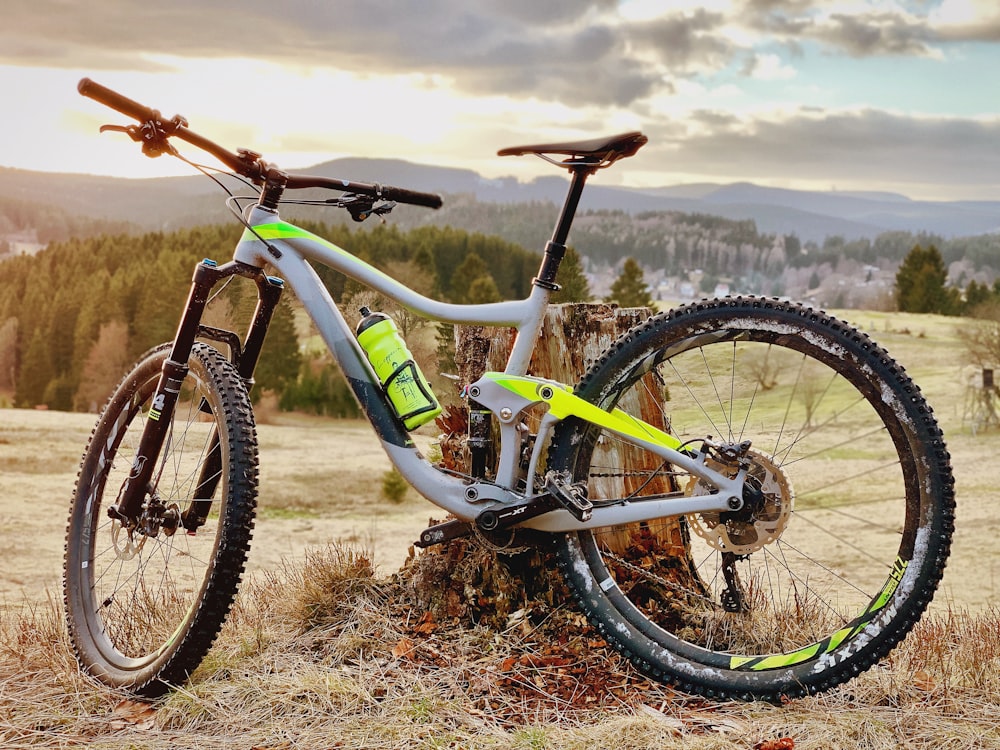
Certain types of full-suspension bikes can fit one water bottle, whereas other types can’t fit any. On the contrary, all hardtails can fit at least one bottle, and some even two.
Versatility could be defined in two ways when comparing a hardtail and a full suspension bike, depending on the type of trails you tackle and what you plan on doing with your mountain bike.
As discussed previously, hardtails are more efficient when climbing and riding on pavement. In addition, they’re just as fast as full-suspension bikes on light trails and gravel paths. Hardtails also allow more customization, including the addition of frame bags, fenders, and bottle cages for longer rides and activities like bikepacking or commuting.
On the other hand, full-suspension bikes allow you to safely tackle a much wider range of technical terrain, including anything from rough cross-country tracks to rapid and technical downhill courses. So if this is what you’re looking for, a full-suspension MTB is the more versatile choice.
It’s worth considering the practicality and convenience regarding maintenance and setup when choosing between a full suspension or a hardtail bike. Hardtails are much less labor-intensive to use and set up, with just the front fork air pressure to calibrate.
Conversely, full-suspension bikes have the extra rear shock to calibrate, and you also have to balance the two suspension components. This difference makes hardtails more practical for regular use.
A Hardtail vs. Full Suspension as Your First Mountain Bike
If you’re choosing your first mountain bike, the standard advice is to select a hardtail first. Using a hardtail will improve your handling and trail riding skills faster as the bikes are much less forgiving, meaning you must ride smarter and you will become a better rider.
Nonetheless, choosing full suspension from the outset will reduce the chance of minor incidents as you have more room for error.
Hardtail vs Full Suspension Pros and Cons
Advantages and Disadvantages of Hardtail Mountain Bikes
- Lighter
- Higher pedaling efficiency
- Excellent for learning mountain biking skills
- Easier to repair and maintain
- Cheaper than the equivalent full-suspension bike
- Faster on pavement and smooth trails
- Better for bikepacking and commuting
- Harder to control and slower on rough terrain
- Unstable when rolling over large obstacles
- Less forgiving if you make a mistake
- Not as fun or safe on bumpier trails
There is a reason many cross-country mountain bikers race aboard hardtails (or full-suspension bikes with limited rear suspension), it is the hardtail’s combination of high efficiency and capability. The suspension on the front is great for absorbing bumps and helping riders through rough sections of the course.
The stiff rear end offers a solid pedaling platform so riders can pedal hard without any suspension-bob (when a rider pedals and the rear suspension compresses under the force) that is often found on full suspension bikes.
These advantages highlight why many cross-country mountain bikers use hardtails for racing; the efficiency and lower weight make them even faster when climbing and riding on smoother trails.
Another benefit to hardtails is that they are usually much lighter than full-suspension bikes. So for mountain bikers who don’t want anything too heavy, but still need some suspension, a hardtail is a good option.
A hardtail is good for its middle ground abilities, but that is also its downfall. A hardtail is okay off-road, but on really rough trails you will want a full-suspension bike. A hardtail is decent on the road, but if you plan on riding a mix of road and off-road routes, then a gravel bike would be much more efficient.
Advantages and Disadvantages of Full-Suspension Bikes
- Easier to control and safer when descending
- More traction, grip and stability
- Faster on rough trails
- Better for racing (except XC)
- Wider margin of error
- More forgiving for new mountain bikers
- Heavier
- More expensive to buy and maintain
- Complicated to set up
- Slower on pavement and smooth trails
- Less efficient when climbing
The biggest benefit of a full-suspension bike is clearly the cushion that it offers when out on a ride. Both the front and rear ends of the bike work hard to absorb bumps, roots, rocks, and pretty much anything else that you ride over.
As the suspension works, it helps the rider maintain momentum through technical sections of a trail, regardless of their line choice.
Another benefit to riding a full suspension bike is the extra traction that the suspension will help you find. As you roll over the rough ground, suspension works to keep your wheels on the ground, which in turn results in more traction and maximum efficiency.
A hardtail will do the job on most off-road terrain, but a full-suspension bike is superior on rough trails. So if the trails you ride aren’t too extreme and you also enjoy riding on roads and gravel, then a hardtail is the best choice.
Confidence is the final benefit that a full-suspension bike tends to offer. When the bike helps absorb a lot of the harshness of a trail, it is easier to find the confidence to ride more aggressively. Lines that are simply not possible on a hardtail bike can become a reality on a full-suspension bike.
One major disadvantage of a full-suspension bike is the suspension-bob. When you pedal hard and the rear suspension compresses, much of your power that would otherwise be forward momentum is lost.
Modern full-suspension bikes have great pedal platforms compared to bikes from 10 years ago, but they are still not as efficient as pedaling a rigid or hardtail bike.
The next problem with full suspension bikes is the extra weight that comes from the rear shock and linkage. Top-quality full suspension bikes are becoming quite lightweight nowadays, but are still not as light as a top-quality hardtail or rigid bike would be.
Hardtail vs. Full Suspension MTBs: Final Thoughts
Before deciding, it’s essential to know what terrain you’ll primarily be riding in order to choose correctly between a hardtail and a full suspension MTB. For example, will you mostly ride very rough, moderate, or light trails, or do you plan to ride on roads and gravel?
After reading this article and answering the above question, you should have a pretty good idea of what style of bike will fit your needs best. Other off-road capable bikes such as gravel or cyclocross styles may also appeal to you, so remember to choose the bike that best matches your riding needs and budget.
There’s no doubt that full-suspension bikes have significantly improved and will likely continue to do so. Still, the added cost, weight, maintenance needs, and inefficiency will remain significant deterrents for riders with less demanding requirements.
Hardtails: The ideal hardtail rider likes to ride both on and off-road. In addition, hardcore mountain bikers who love the extra responsiveness of a solid rear end when out on a trail and the low weight and efficiency for climbing and sprints should also choose a hardtail.
Full suspension bikes: Full suspension bikes are for riders who like to ride rough off-road trails. Thankfully, there are tons of full-suspension designs to suit different riding styles; the harsher the courses you ride, the more suspension your full-suspension bike should have.


